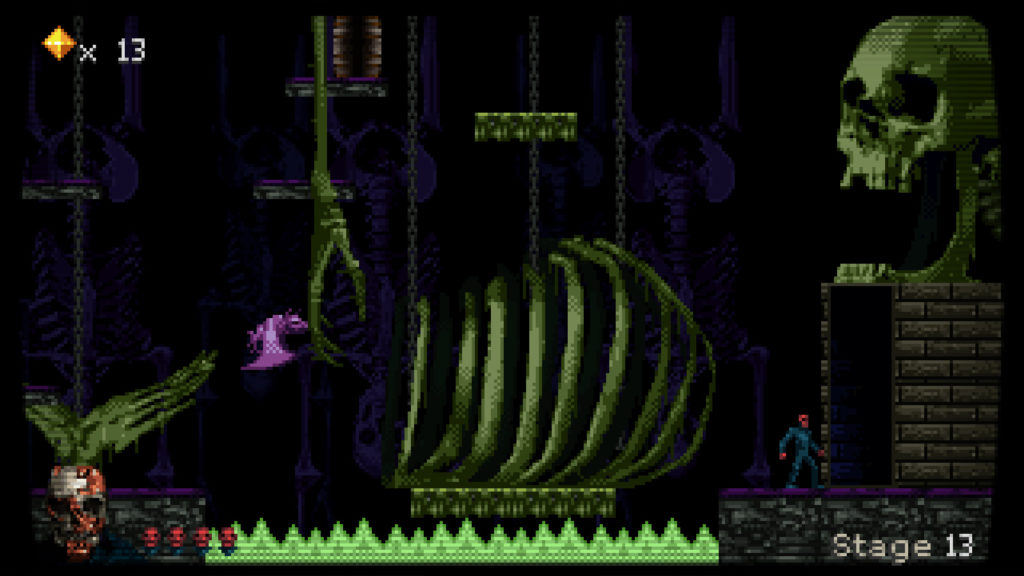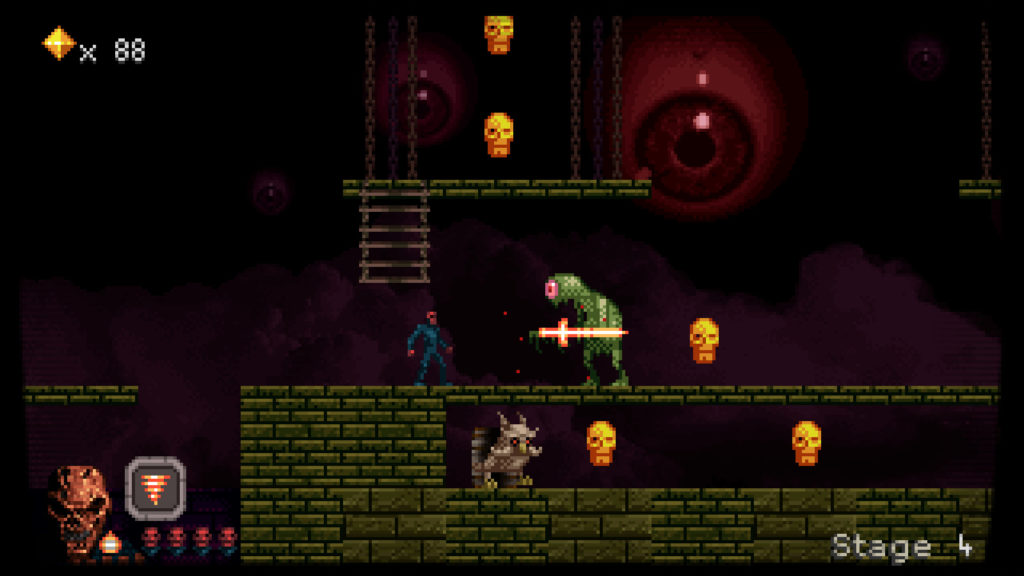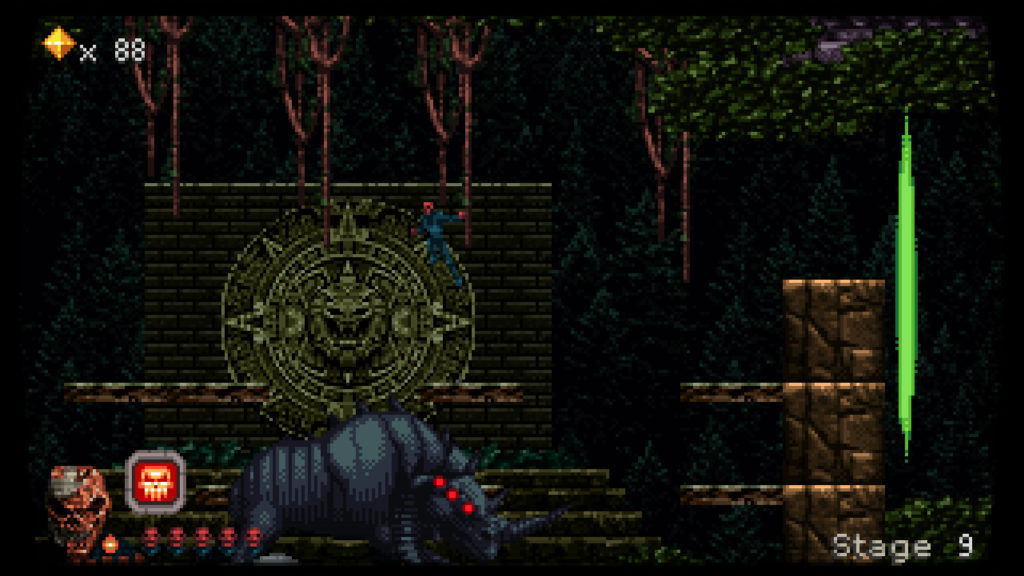First Impression articles are based entirely upon the first roughly 30 minutes of gameplay and may not necessarily be indicative of the game as a whole. This includes the score at the end.
Mastema: Out of Hell has some rough edges. Okay, it has a lot of rough edges. Those edges may even include baffling decisions like mapping your normal attack to the B button on a controller. Despite everything, and much to my own surprise, I enjoyed my time with this game.
You’re Mastema and you want to get out of Hell. That’s basically the entire plot and it’s right there in the title. This is an action platformer which, other than a fairly gory depiction of Mastema on the title screen, would feel right at home on the Genesis. It nails the style of the era across the board. The dark color palette with a focus on greens and reds not only looks authentic, it looks great. Various aesthetic touches like an over-the-top death scream, green waterfalls made of damned souls, crispy sound effects, giant skull piles and, of course, floating gems which periodically transform into skulls as this game’s version of coins all come together to capture the best of the in-your-face extreme edginess from the 90’s. Mastema: Out of Hell looks and sounds phenomenal while staying true to its chosen style.

I normally like to discuss a game’s issues closer to the end of an article, but this time I’ll be diving right in. To begin with, there’s no options menu. Instead, you set the CRT filter on or off when the game launches. You also need to press J for joypad controls and K for keyboard controls. You can swap between the two at any point, but it’s a strange choice and you can’t use a controller at all until pressing J. Since there’s no options menu, there also doesn’t seem to be a way to play the game in windowed mode. You can’t reconfigure the controls either, so you’re out of luck if you want to use X to attack instead of B. Though the game automatically saves your progress, the main menu always defaults to New Game, which makes me feel like I’m always one wrong button press away from losing my data.
The rough edges extend beyond menu options and key bindings. Some of the programming feels amateurish. For example, Mastema can jump through moving platforms, but he can’t actually jump on top of them from below because his feet get stuck inside them and pull him back down. Meanwhile, when you’re riding a moving platform the whole thing jitters slightly like you’re going to fall off of it. I’m confident you could clip through some walls with a bit of effort. Mastema is also completely incapable of jumping horizontally when he’s near a wall. Even if he jumps above it he won’t be able to move left and right. Trying to jump on a ledge only to find that I needed to back away slightly and try again was a common occurrence.
There are also a few issues with the level design. Crumbling floor tiles aren’t a problem later on, but in the first region they blend in a bit too well with the rest of the floor. Mastema: Out of Hell also has an odd habit of briefly spiking its difficulty from time to time. Every three levels or so it likes to throw a single pixel perfect jump at you. Levels are short and even if you run out of lives you only get sent back to the start of the current set of three so you never lose much progress from this. Regardless, these spikes occur just frequently enough to stand out. You can go through half of a reasonably difficult level, die multiple times to a single incredibly demanding jump, and then go back to facing reasonable challenges for the rest of the level after making the jump. These are big, singular spikes in difficulty which the game treats as though they are in line with the challenges surrounding them.

With all these issues, how could I possibly enjoy this game? Because the rest of it is fantastic. Part of the reason why the difficult spikes and control oddities stand out so much is that the rest of the level design is remarkably solid, fusing together puzzle and action elements. Despite its appearance and setting, this isn’t a game where you’re constantly charging forward with guns blazing. In fact, most of the time you don’t have any sort of weapon at all.
Special attacks are single use items which usually take on the form of a flaming skull or some other large object killing everything in a horizontal line. As for your normal attack, it’s a rather nice ranged energy sword, but there’s a catch. You have to find this sword within a level to use it and you lose it if you die. Even though you can carry the sword between levels, many levels do not have the sword at all, so if you die in them you’ll just have to avoid enemies and rely on any special attacks you find.
I think the main reason why this game works overall is that fusion of puzzle and action elements I mentioned. I don’t just mean that it has some switches and keys scattered around, though it does indeed have those. Rather, the puzzles take on the form of action elements. Swords and special attacks aren’t so much combat tools as they are keys. If a level has a sword in it, there’s a good chance that the sword is placed on a side branch and you’ll need a sword to kill an enemy which would otherwise be impossible to pass without taking damage. Special attacks serve a similar purpose as they are often placed on side paths or within objects (which you need the sword to destroy) shortly before a tough enemy appears on the main path.

This game also benefits from some great pacing. I was initially not a fan of the fact that Mastema will automatically jump again if you are still holding down the jump button when he lands, but this design decision makes sense within the scope of the game. Crumbling or otherwise falling platforms disappear almost instantaneously after being touched, so you really do need that automatic, immediate jump from holding down the button. An alternative solution would be to ditch the automatic jumping and make platforms take more time to crumble, but that would interfere with the smooth flow of the game.
The good pacing applies to more than just the jumping and this is again where the puzzle elements come into play. You’ll often want to stop in a safe location for a moment to take a good look at what’s around you. Getting swords and special attacks is important, but so is figuring out which enemy or obstacle you’re intended to use them on; the game rarely gives you a power out of pure generosity. Once you plan out a path, you often need to move through it with few, if any, pauses in order to survive chains of crumbling platforms and to line up moving platforms with enemy patrol patterns. The end result is an interesting mix of rapid, flowing action and patient, thoughtful pauses.
There are other things to like about the design here as well. My initial impression of some of the levels without swords was that they felt balanced with a sword in mind, but I’ve reversed my opinion in this regard after reflecting on my experience as a whole. These levels are indeed easier if you go through them with a sword from a previous level, but the sword is more of a bonus than a necessity. They are still entirely reasonable, though challenging, without a sword and any difficulty spikes within them came from those occasional pixel perfect jumps rather than from enemies.

Content is another strong point. From what I could see of the world map there are two choices for every third region, giving the game high replay value. There is a bit of an issue here with the branches themselves being unclear since going through the top door at the end of the second region took me to the lower third region on the map, but that’s rather minor. Other than branching regions, there is also just a lot of content in general. I thought I was somewhere around halfway through the game after finishing four regions, but I was really just scratching the surface. The Steam page claims that the game has 20 regions, meaning you’ll go through quite a few on a single run even when taking branches into account and with three levels per region this is a lengthy platformer indeed. Tons of enemy variety also goes a long way towards preventing the platforming from getting stale.
Mastema: Out of Hell has all sorts of flaws of varying types and sizes. None of these flaws affect the core gameplay, though they’re definitely enough to turn some players away. However, anyone who can tolerate the issues here will find that what remains is a real hidden gem of a game with great aesthetics and clever design.
First Impression Verdict: Good 4/5